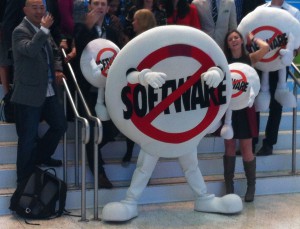 I was meeting with a potential new client in Dallas last week scoping a new project when the conversation took an interesting turn. They started talking about how their parent company was also interested in Salesforce.com and might be a good future client for us as well. At that point I stopped them and asked if they had considered having a single Salesforce instance with both companies working in a single database rather than buying two separate orgs. It was something they hadn’t considered, and for many businesses that own multiple operating companies in the same vertical or who sell to the same customer base, it makes all the sense in the world.
I was meeting with a potential new client in Dallas last week scoping a new project when the conversation took an interesting turn. They started talking about how their parent company was also interested in Salesforce.com and might be a good future client for us as well. At that point I stopped them and asked if they had considered having a single Salesforce instance with both companies working in a single database rather than buying two separate orgs. It was something they hadn’t considered, and for many businesses that own multiple operating companies in the same vertical or who sell to the same customer base, it makes all the sense in the world.
Here is a quick list of the advantages that come with having a single org, rather than two distinct Salesforce implementations:
Pricing Leverage with Salesforce
If you’ve been a customer for any time with Salesforce, you know that you get a better deal on your license costs when you buy more at one time (aka the volume discount). If you split the number of licenses between two orgs, you’re losing a lot of pricing leverage. The same applies with other Salesforce products like Data.com, portal license, etc.
Administrator Headcount
Even a company with a handful of users has to have someone in their organization on point to handle Salesforce requests from users and management. Of course this depends on the size of the two orgs, but the thought here is if you have two orgs, you’re going to have at least two individuals acting in the role of “Salesforce Administrator.” If you collapse down to one org, you might be able to get away with one.
Common Customer Database
Marketing always wants to expand their database of customers and prospects. If the two operating companies market to the same audience, the benefit is obvious – more contacts in a single place!
Cross Sell & Referral Opportunities
If the operating companies are in the same vertical, it becomes easier to cross-sell or up-sell in a common customer database. Nothing like a warm lead versus dialing for dollars! For example:
“We don’t offer that product line, but our sister-company does. Let me introduce you to that sales rep.”
“I see you have equipment installed at your location from our parent company. That will make it a snap for us to integrate with your systems.”
“Hi Janice, Alex Rodriguez who works at xyz corp – a subsidiary of ours – recommended that I speak with you.”
Single Integration Point
Let’s say that both companies want to integrate with a payment processor, or maybe a third party marketing automation platform. It’s much easier to manage a single integration point than two.
Shared Tools
When it comes to AppExchange solutions, you’re leveraging the benefit of having third party Salesforce widget over a greater amount of users and records (think data cleansing / de-duplication, email marketing, e-signature, etc)
Greater Data Visibility
This is the big one, and probably the most compelling for management. With a single org you can roll-up pipelines, sales and other KPIs across multiple operating companies into a single dashboard. With two Salesforce orgs, you’re back to using spreadsheets (ick!).
Make It Feel Like Home
By using security and careful record ownership your users should feel like they are swimming around in their own little fishbowl, rather than a big ocean shared with their sister companies. Additionally you can tailor their experience to fee like home. Well, at least like their respective company by having branding in the following areas:
- Quotes Templates
- Email Templates
- Their assigned “App” (i.e. their collection of tabs)
Are There Negatives?
With any large org, you have added complexity – more security, more customization, more profiles, and more data to keep clean. However, I wouldn’t make these a reason not to have a single org. If you have hundreds of users, these issues come into play whether it’s a single operating company or multiple in a single Salesforce instance. The real issue here is that with a hundreds of users, you’re wrangling a BIG org!
Final Thoughts
Yes, you really do need Enterprise Edition (or higher). Don’t try to pull off two operating companies in a single org using Professional Edition. It will be a horrible experience for everyone involved. Enterprise has some key features that are designed to support multiple business processes. Here is a short list of the features you can expect to leverage in Enterprise Edition to allow everyone to play nicely in a single org:
- Enterprise Analytics
- Enhanced Security
- Custom User Profiles
- Multiple Page Layouts & Record Types
Plus you’ll get the extra efficiency and flexibility out of having workflow and higher governor limits in Enterprise Edition.
If you would like assistance evaluating a Salesforce.com for your company, please contact us!